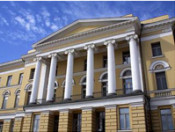
History of Russia abroad: University of Helsinki opened its “Russian collections”
Finland is known to be a part of the Russian Empire more than a hundred years – until the death of the Empire itself. A lot of documentary evidence related to the period is stored in the book collection of the University of Helsinki – a famous “Slavika”. In the year of the 400th anniversary, the University of Helsinki opened its “Russian collections”.
The collection, the existence of which is known today only to a narrow circle of specialists in the history of the Great Duchy of Finland, is located in the building of the geological museum of the University of Helsinki. The massive cast-iron staircase leads to the premises of the museum with a rare collection of portraits of the Romanovs.
“In the fates of these paintings can be traced the Finnish attitude to the imperial heritage. At the beginning of the XIX century this was a delight and a complete loyalty, portraits were housed in the university, as tsars have traditionally been chancellors of the institution. They always hung on the most honorable places, and it was not until 1918”, - says Professor of History studies Henrik Meynander.
After the Russian Revolution and the Civil War in Finland Romanov portraits were hidden in the back rooms of the University, the interest to them has arisen only in the mid-1970s, with knowledge of the role of Russian emperors in the development of Duchy of Finland.
One of the examples of such a development will be the album of 1819 dedicated to the journey through Suomi of Alexander I. This is the first detailed historical account of northern regions of Finland. The books with the monogram of Paul I, signed by Mikhail Lomonosov, a book collection of Mon Repos estate owners - these unique publications are part of the collection “Slavika”, numbering about 500,000 books. Since the 40s of the XIX century, they are stored in the National Library, which was built by Carl Ludwig Engel.
The most colorful part of the “Slavika” is posters of the early XX century. One of the sheets calls to use the services of Scandinavian Express plying between Saint-Petersburg and Stockholm. The prototype of modern ferry lines and high-speed trains kept the old image of the Finland Station.
“The basis of the collection of Slavonic library consists of books, magazines and newspapers that we have received free of charge from Imperial Russia on the basis of Decree 1828 of censorship. Thus, it was received more than 100,000 books”, - says the curator of the Slavic Department of the National Library Irma Rayonen.
The replenishment of “Slavika” was interrupted in 1917, but after a few years, the Finns continued to gather Russian-language literature.

